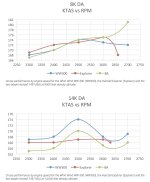If a prop is pitched for a certain airspeed, will it perform or react the same at high altitudes as it would at sea level? For example, if an RV (particularly an RV 9), has a prop that’s pitched so that it gets close to top end at 140 kts ias, that may be considered under pitched at lower altitudes compared to a prop that could fly over 160kts. But if you climb to 15k feet, 140kts ias would likely be at least 180 kts true airspeed (people on here have stated that 13—17k feet is the sweet spot for 9’s), so that wouldn’t seem underpitched in that circumstance. Never having flown an RV (or any EAB for that matter), I don’t know what the typical indicated airspeeds are at higher altitudes.
If you planned on flying at much higher altitude, could you be better off pitching the prop a bit lower than someone who plans to slice through the air at 160-170kts below 5k feet? This is assuming the aircraft is equipped with a fixed-pitch prop.
If you planned on flying at much higher altitude, could you be better off pitching the prop a bit lower than someone who plans to slice through the air at 160-170kts below 5k feet? This is assuming the aircraft is equipped with a fixed-pitch prop.





